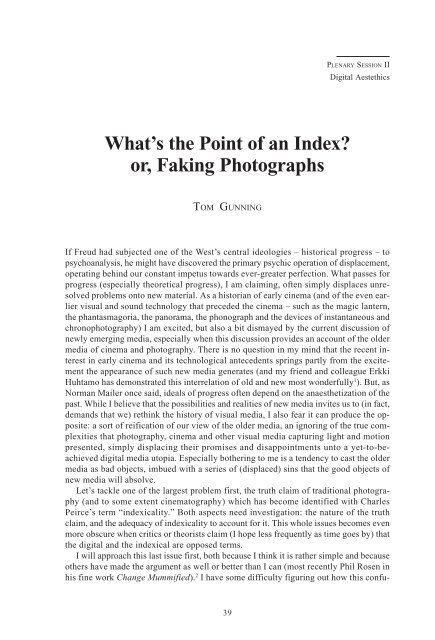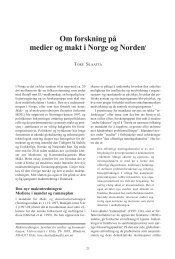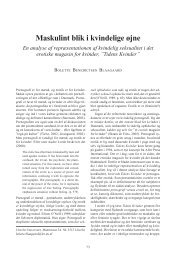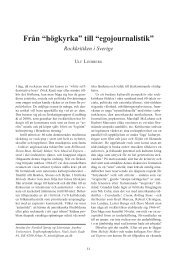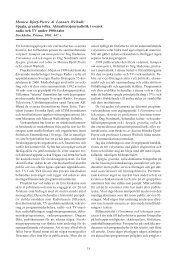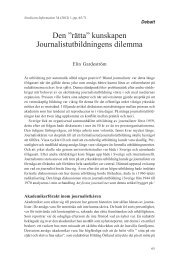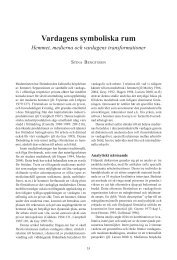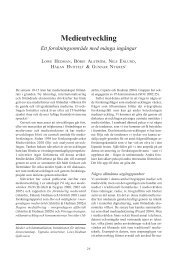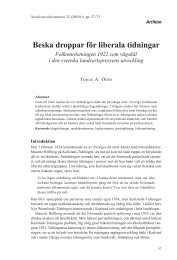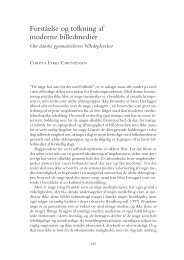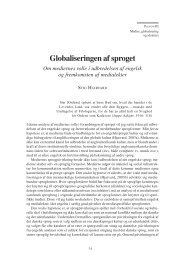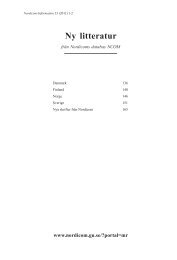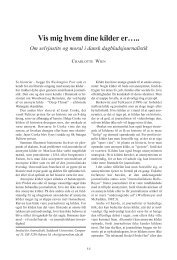What's the Point of an Index? or, Faking Photographs - Nordicom
What's the Point of an Index? or, Faking Photographs - Nordicom
What's the Point of an Index? or, Faking Photographs - Nordicom
You also want an ePaper? Increase the reach of your titles
YUMPU automatically turns print PDFs into web optimized ePapers that Google loves.
WHAT’S THE POINT OF AN INDEX? OR, FAKING PHOTOGRAPHS<br />
What’s <strong>the</strong> <strong>Point</strong> <strong>of</strong> <strong>an</strong> <strong>Index</strong>?<br />
<strong>or</strong>, <strong>Faking</strong> <strong>Photographs</strong><br />
TOM GUNNING<br />
39<br />
PLENARY SESSION II<br />
Digital Aestethics<br />
If Freud had subjected one <strong>of</strong> <strong>the</strong> West’s central ideologies – hist<strong>or</strong>ical progress – to<br />
psycho<strong>an</strong>alysis, he might have discovered <strong>the</strong> primary psychic operation <strong>of</strong> displacement,<br />
operating behind our const<strong>an</strong>t impetus towards ever-greater perfection. What passes f<strong>or</strong><br />
progress (especially <strong>the</strong><strong>or</strong>etical progress), I am claiming, <strong>of</strong>ten simply displaces unresolved<br />
problems onto new material. As a hist<strong>or</strong>i<strong>an</strong> <strong>of</strong> early cinema (<strong>an</strong>d <strong>of</strong> <strong>the</strong> even earlier<br />
visual <strong>an</strong>d sound technology that preceded <strong>the</strong> cinema – such as <strong>the</strong> magic l<strong>an</strong>tern,<br />
<strong>the</strong> ph<strong>an</strong>tasmag<strong>or</strong>ia, <strong>the</strong> p<strong>an</strong><strong>or</strong>ama, <strong>the</strong> phonograph <strong>an</strong>d <strong>the</strong> devices <strong>of</strong> inst<strong>an</strong>t<strong>an</strong>eous <strong>an</strong>d<br />
chronophotography) I am excited, but also a bit dismayed by <strong>the</strong> current discussion <strong>of</strong><br />
newly emerging media, especially when this discussion provides <strong>an</strong> account <strong>of</strong> <strong>the</strong> older<br />
media <strong>of</strong> cinema <strong>an</strong>d photography. There is no question in my mind that <strong>the</strong> recent interest<br />
in early cinema <strong>an</strong>d its technological <strong>an</strong>tecedents springs partly from <strong>the</strong> excitement<br />
<strong>the</strong> appear<strong>an</strong>ce <strong>of</strong> such new media generates (<strong>an</strong>d my friend <strong>an</strong>d colleague Erkki<br />
Huhtamo has demonstrated this interrelation <strong>of</strong> old <strong>an</strong>d new most wonderfully 1 ). But, as<br />
N<strong>or</strong>m<strong>an</strong> Mailer once said, ideals <strong>of</strong> progress <strong>of</strong>ten depend on <strong>the</strong> <strong>an</strong>aes<strong>the</strong>tization <strong>of</strong> <strong>the</strong><br />
past. While I believe that <strong>the</strong> possibilities <strong>an</strong>d realities <strong>of</strong> new media invites us to (in fact,<br />
dem<strong>an</strong>ds that we) rethink <strong>the</strong> hist<strong>or</strong>y <strong>of</strong> visual media, I also fear it c<strong>an</strong> produce <strong>the</strong> opposite:<br />
a s<strong>or</strong>t <strong>of</strong> reification <strong>of</strong> our view <strong>of</strong> <strong>the</strong> older media, <strong>an</strong> ign<strong>or</strong>ing <strong>of</strong> <strong>the</strong> true complexities<br />
that photography, cinema <strong>an</strong>d o<strong>the</strong>r visual media capturing light <strong>an</strong>d motion<br />
presented, simply displacing <strong>the</strong>ir promises <strong>an</strong>d disappointments unto a yet-to-beachieved<br />
digital media utopia. Especially bo<strong>the</strong>ring to me is a tendency to cast <strong>the</strong> older<br />
media as bad objects, imbued with a series <strong>of</strong> (displaced) sins that <strong>the</strong> good objects <strong>of</strong><br />
new media will absolve.<br />
Let’s tackle one <strong>of</strong> <strong>the</strong> largest problem first, <strong>the</strong> truth claim <strong>of</strong> traditional photography<br />
(<strong>an</strong>d to some extent cinematography) which has become identified with Charles<br />
Peirce’s term “indexicality.” Both aspects need investigation: <strong>the</strong> nature <strong>of</strong> <strong>the</strong> truth<br />
claim, <strong>an</strong>d <strong>the</strong> adequacy <strong>of</strong> indexicality to account f<strong>or</strong> it. This whole issues becomes even<br />
m<strong>or</strong>e obscure when critics <strong>or</strong> <strong>the</strong><strong>or</strong>ists claim (I hope less frequently as time goes by) that<br />
<strong>the</strong> digital <strong>an</strong>d <strong>the</strong> indexical are opposed terms.<br />
I will approach this last issue first, both because I think it is ra<strong>the</strong>r simple <strong>an</strong>d because<br />
o<strong>the</strong>rs have made <strong>the</strong> argument as well <strong>or</strong> better th<strong>an</strong> I c<strong>an</strong> (most recently Phil Rosen in<br />
his fine w<strong>or</strong>k Ch<strong>an</strong>ge Mummified). 2 I have some difficulty figuring out how this confu-
TOM GUNNING<br />
sion arose, but I imagine it went something like this: <strong>the</strong> indexicality <strong>of</strong> <strong>the</strong> photograph<br />
depends on a physical relation between <strong>the</strong> object photographed <strong>an</strong>d <strong>the</strong> image finally<br />
created. The image on <strong>the</strong> photographic negative derives from <strong>the</strong> tr<strong>an</strong>sf<strong>or</strong>mation <strong>of</strong> light<br />
sensitive emulsion caused by light reflecting <strong>of</strong>f <strong>the</strong> object photographed filtered through<br />
<strong>the</strong> lens <strong>an</strong>d diaphragm. In a digital image, however, instead <strong>of</strong> light sensitive emulsion<br />
affected by <strong>the</strong> luminous object, <strong>the</strong> image is f<strong>or</strong>med through data about light that is<br />
encoded in a matrix <strong>of</strong> numbers.<br />
But what problem does this ch<strong>an</strong>ge present <strong>an</strong>d how does it challenge indexicality?<br />
Clearly a digital camera rec<strong>or</strong>ds through its numerical data <strong>the</strong> same intensities <strong>of</strong> light<br />
that a non-digital camera rec<strong>or</strong>ds: hence <strong>the</strong> similarity <strong>of</strong> <strong>the</strong>ir images. The difference<br />
between <strong>the</strong> digital <strong>an</strong>d <strong>the</strong> film based camera has to do with <strong>the</strong> way <strong>the</strong> inf<strong>or</strong>mation is<br />
captured – which does have strong implications f<strong>or</strong> <strong>the</strong> way <strong>the</strong> images c<strong>an</strong> be st<strong>or</strong>ed,<br />
tr<strong>an</strong>sferred <strong>an</strong>d indeed m<strong>an</strong>ipulated. But st<strong>or</strong>age in terms <strong>of</strong> numerical data does not<br />
eliminate indexicality (which is why digital images c<strong>an</strong> serves as passp<strong>or</strong>t photographs<br />
<strong>an</strong>d <strong>the</strong> o<strong>the</strong>r s<strong>or</strong>ts <strong>of</strong> legal evidence <strong>or</strong> documents, which <strong>or</strong>dinary photographs supply).<br />
Fur<strong>the</strong>r, it would be foolish to closely identify <strong>the</strong> indexical with <strong>the</strong> photographic; most<br />
indexical inf<strong>or</strong>mation is not rec<strong>or</strong>ded by photography. Long bef<strong>or</strong>e digital media were<br />
introduced, medical instruments <strong>an</strong>d o<strong>the</strong>r instrument <strong>of</strong> measurement, indexical instruments<br />
par excell<strong>an</strong>ce – such as devices f<strong>or</strong> reading pulse rate, temperature, heart rate,<br />
etc, <strong>or</strong> speedometers, wind gauges, <strong>an</strong>d barometers – all converted <strong>the</strong>ir inf<strong>or</strong>mation into<br />
numbers.<br />
Although a photograph combines both types <strong>of</strong> signs, <strong>the</strong> indexical quality <strong>of</strong> a photograph<br />
must not be confused with its iconicity. The fact that rows <strong>of</strong> numbers do not<br />
resemble a photograph, <strong>or</strong> what <strong>the</strong> photograph is supposed to represent, does not undermine<br />
<strong>an</strong>y indexical claim. An index need not (<strong>an</strong>d frequently does not) resemble <strong>the</strong> thing<br />
it represents. The indexicality <strong>of</strong> a traditional photograph inheres in <strong>the</strong> effect <strong>of</strong> light on<br />
chemicals, not in <strong>the</strong> picture it produces. The rows <strong>of</strong> numerical data produced by a digital<br />
camera <strong>an</strong>d <strong>the</strong> image <strong>of</strong> traditional chemical photography are both indexically determined<br />
by objects outside <strong>the</strong> camera. Both photographic chemicals <strong>an</strong>d <strong>the</strong> digital data<br />
must be subjected to elab<strong>or</strong>ate procedures bef<strong>or</strong>e a picture will result. Here we might<br />
grasp how <strong>the</strong> claim f<strong>or</strong> digital uniqueness displaces a problematic issue within our conception<br />
<strong>of</strong> traditional photography, <strong>an</strong> especially pernicious one. The claim that <strong>the</strong> digital<br />
media alone tr<strong>an</strong>sf<strong>or</strong>ms its data into <strong>an</strong> intermediary f<strong>or</strong>m fosters <strong>the</strong> myth that photography<br />
involves a tr<strong>an</strong>sparent process, a direct tr<strong>an</strong>sfer from <strong>the</strong> object to <strong>the</strong> photograph.<br />
The mediation <strong>of</strong> lens, film stock, exposure rate, type <strong>of</strong> shutter, processes <strong>of</strong><br />
developing <strong>an</strong>d <strong>of</strong> printing become magically whisked away if one considers <strong>the</strong> photograph<br />
as a direct imprint <strong>of</strong> reality.<br />
Thus <strong>the</strong> very strong claim that digital images c<strong>an</strong> be m<strong>an</strong>ipulated in ways photographic<br />
images could not, must also be qualified. Indeed <strong>the</strong> much-heralded malleability<br />
<strong>of</strong> <strong>the</strong> digital image does not contrast absolutely with photography. I would not deny<br />
that <strong>the</strong> ease, speed <strong>an</strong>d quality <strong>of</strong> digital m<strong>an</strong>ipulation represent <strong>an</strong> imp<strong>or</strong>t<strong>an</strong>t new stage<br />
in <strong>the</strong> technology <strong>of</strong> imagery. But we must carefully consider <strong>the</strong> situations in which such<br />
malleability becomes a value <strong>an</strong>d <strong>the</strong> considerable debt such tr<strong>an</strong>sf<strong>or</strong>mations owe to<br />
(although <strong>of</strong>ten displacing our attention from) <strong>the</strong> hist<strong>or</strong>y <strong>of</strong> photography. Here especially,<br />
<strong>the</strong> intertwining <strong>of</strong> indexicality <strong>an</strong>d iconicity must be observed.<br />
Let us gr<strong>an</strong>t f<strong>or</strong> <strong>the</strong> moment, <strong>the</strong> ability <strong>of</strong> digital photography to absolutely tr<strong>an</strong>sf<strong>or</strong>m<br />
<strong>the</strong> appear<strong>an</strong>ce <strong>of</strong> <strong>the</strong> object <strong>or</strong>iginally photographed. If we gr<strong>an</strong>t that <strong>the</strong> <strong>or</strong>iginal digital<br />
photograph <strong>of</strong> Uncle Harry was indexical (<strong>an</strong>d <strong>the</strong>ref<strong>or</strong>e bears <strong>an</strong> imp<strong>or</strong>t<strong>an</strong>t relation<br />
40
WHAT’S THE POINT OF AN INDEX? OR, FAKING PHOTOGRAPHS<br />
to <strong>the</strong> actual Uncle Harry), what happens when we <strong>the</strong>n intervene on <strong>the</strong> data in a Photoshop<br />
program <strong>an</strong>d tr<strong>an</strong>sf<strong>or</strong>m his nose into a pronounced beak, his baldhead into a shaggy<br />
wilderness, turn his brown eyes blue? Surely <strong>the</strong> indexical is being attenuated! Two <strong>an</strong>swers<br />
are relev<strong>an</strong>t here, both <strong>of</strong> which depend on a qualified yes. Yes, but … film-based<br />
photography c<strong>an</strong> also tr<strong>an</strong>sf<strong>or</strong>m Uncle Harry’s appear<strong>an</strong>ce, whe<strong>the</strong>r through retouching,<br />
use <strong>of</strong> filters <strong>or</strong> lenses, selection <strong>of</strong> <strong>an</strong>gle <strong>of</strong> photography, exposure time, use <strong>of</strong> specially<br />
prepared chemicals in <strong>the</strong> developing stage, <strong>or</strong> adding elements through multiple printing.<br />
Traditional photography, <strong>the</strong>ref<strong>or</strong>e, also possesses processes that c<strong>an</strong> attenuate, ign<strong>or</strong>e,<br />
<strong>or</strong> even undo <strong>the</strong> indexical. No question digital processes c<strong>an</strong> perf<strong>or</strong>m <strong>the</strong>se alterations<br />
m<strong>or</strong>e quickly <strong>an</strong>d m<strong>or</strong>e seamlessly, but <strong>the</strong> difference between digital <strong>an</strong>d filmbased<br />
photography c<strong>an</strong>not be described as absolute.<br />
But a m<strong>or</strong>e complex <strong>an</strong>d, I think, m<strong>or</strong>e interesting <strong>an</strong>swer would point out that <strong>the</strong><br />
power <strong>of</strong> <strong>the</strong> digital (<strong>or</strong> even <strong>the</strong> traditional photographic) to “tr<strong>an</strong>sf<strong>or</strong>m” <strong>an</strong> image depends<br />
on maintaining something <strong>of</strong> <strong>the</strong> <strong>or</strong>iginal image’s visual accuracy <strong>an</strong>d recognizability.<br />
I use this phrase (“visual accuracy <strong>an</strong>d recognizability”) to indicate <strong>the</strong> m<strong>an</strong>ner<br />
in which indexicality intertwines with iconicity in our common assessment <strong>of</strong> photographs.<br />
Our evaluation <strong>of</strong> a photograph as accurate (i.e. visually reflecting its subject)<br />
depends not simply on its indexical basis (<strong>the</strong> chemical process), but on our recognition<br />
<strong>of</strong> it as looking like its subject. A host <strong>of</strong> psychological <strong>an</strong>d perceptual processes intervene<br />
here which c<strong>an</strong>not be reduced to <strong>the</strong> indexical process. The recognition <strong>of</strong> a photograph<br />
by a viewer as <strong>an</strong> image <strong>of</strong> its subject would not simply result from indexically.<br />
Indeed, one could produce <strong>an</strong> indexical image <strong>of</strong> something <strong>or</strong> someone that remained<br />
unrecognizable. The image must also be legible in <strong>or</strong>der to be likened to its subject.<br />
Let me get at this via <strong>an</strong>o<strong>the</strong>r route. If one <strong>of</strong> <strong>the</strong> great consequences <strong>of</strong> <strong>the</strong> digital<br />
revolution lies in <strong>the</strong> freedom it gives people to tr<strong>an</strong>sf<strong>or</strong>m a photographic image, we<br />
could say that <strong>the</strong> digital aspires to <strong>the</strong> condition <strong>of</strong> painting, in which col<strong>or</strong>, shape, texture,<br />
all <strong>the</strong> components <strong>of</strong> <strong>an</strong> image are completely up to <strong>the</strong> painter, ra<strong>the</strong>r th<strong>an</strong> determined<br />
by <strong>the</strong> <strong>or</strong>iginal subject through <strong>an</strong> indexical process. But do users <strong>of</strong> Photoshop<br />
w<strong>an</strong>t <strong>an</strong> absolute freedom? Do <strong>the</strong>y really w<strong>an</strong>t to create <strong>an</strong> image <strong>or</strong>, ra<strong>the</strong>r, to tr<strong>an</strong>sf<strong>or</strong>m<br />
one which c<strong>an</strong> still be recognized as a photograph (<strong>an</strong>d maybe even as a photograph<br />
<strong>of</strong> Uncle Harry?)<br />
The interest in tr<strong>an</strong>sf<strong>or</strong>ming Uncle Harry’s photograph is not quite <strong>the</strong> same as that<br />
<strong>of</strong> drawing a caricature <strong>of</strong> him. Admittedly one could point out that few <strong>of</strong> us have <strong>the</strong><br />
depictive talent to produce a caricature, <strong>an</strong>d that digital m<strong>an</strong>ipulation programs give us<br />
that power (interestingly this recalls <strong>the</strong> argument Fox Talbot gave f<strong>or</strong> his invention <strong>of</strong><br />
photography). But it seems to me that <strong>the</strong> power <strong>of</strong> most digital m<strong>an</strong>ipulation <strong>of</strong> photographs<br />
depends on our recognizing <strong>the</strong>m as m<strong>an</strong>ipulated photographs, being aware <strong>of</strong><br />
<strong>the</strong> strata <strong>of</strong> <strong>the</strong> indexical (<strong>or</strong> perhaps better, <strong>the</strong> visually recognizable) beneath <strong>the</strong> m<strong>an</strong>ipulation.<br />
The wonderful playfulness celebrated in <strong>the</strong> digital revolution remains parasitic on <strong>the</strong><br />
initial claim <strong>of</strong> accuracy contained in some uses <strong>of</strong> photography. Just as I tried to unt<strong>an</strong>gle<br />
<strong>the</strong> idea <strong>of</strong> visual accuracy from simple indexicality, I would now like to consider <strong>the</strong><br />
“truth claim” <strong>of</strong> photography that relies on both indexicality <strong>an</strong>d visual accuracy but<br />
includes m<strong>or</strong>e (<strong>an</strong>d perhaps less) th<strong>an</strong> ei<strong>the</strong>r <strong>of</strong> <strong>the</strong>m. A great deal <strong>of</strong> <strong>the</strong> discussion <strong>of</strong><br />
<strong>the</strong> digital revolution has involved its effect <strong>of</strong> <strong>the</strong> truth claim <strong>of</strong> photography, ei<strong>the</strong>r from<br />
a par<strong>an</strong>oid position (photographs will be m<strong>an</strong>ipulated to serve as evidence <strong>of</strong> things<br />
which do not exist <strong>the</strong>reby m<strong>an</strong>ipulating <strong>the</strong> population to believe in things that do not<br />
exist), <strong>or</strong> from what we might call a schizophrenic position (celebrating <strong>the</strong> release <strong>of</strong><br />
41
TOM GUNNING<br />
photographic images from claims <strong>of</strong> truth, issuing in a w<strong>or</strong>ld presumably <strong>of</strong> universal<br />
doubt <strong>an</strong>d play, allowing us to cav<strong>or</strong>t endlessly in <strong>the</strong> veils <strong>of</strong> Maya).<br />
I use <strong>the</strong> w<strong>or</strong>d “truth claim” because I w<strong>an</strong>t to emphasize that this is not simply a<br />
property inherent in a photograph, but a claim made f<strong>or</strong> it (dependent, <strong>of</strong> course, on our<br />
underst<strong>an</strong>ding <strong>of</strong> its inherent properties). Perhaps its Ur-f<strong>or</strong>m c<strong>an</strong> be found in Dion<br />
Boucicualt’s 1859 melodrama The Oct<strong>or</strong>oon, in which Scudder, <strong>the</strong> play’s Y<strong>an</strong>kee “photographic<br />
operat<strong>or</strong>”, discovers that <strong>an</strong> act <strong>of</strong> murder has been rec<strong>or</strong>ded by a camera. He<br />
<strong>of</strong>fers <strong>the</strong> photograph as evidence to a lynch mob about to string up <strong>an</strong> Indi<strong>an</strong> falsely<br />
accused <strong>of</strong> <strong>the</strong> murder, declaring, “’Tis true! <strong>the</strong> apparatus c<strong>an</strong>’t lie!” 3<br />
We might add immediately that <strong>the</strong> apparatus, in itself, c<strong>an</strong> nei<strong>the</strong>r lie, n<strong>or</strong> tell <strong>the</strong> truth.<br />
Bereft <strong>of</strong> l<strong>an</strong>guage, a photograph relies on people to say things about it <strong>or</strong> f<strong>or</strong> it. It is no<br />
accident that Boucicault’s melodrama involves a mock trial in which <strong>the</strong> photograph exonerates<br />
<strong>the</strong> falsely accused Indi<strong>an</strong> chief Wahnotee <strong>an</strong>d determines <strong>the</strong> true culprit. Given<br />
<strong>the</strong> early date <strong>of</strong> this play characters question whe<strong>the</strong>r a court <strong>of</strong> law would actually accept<br />
such evidence. Both hist<strong>or</strong>ically <strong>an</strong>d institutionally, in <strong>or</strong>der to tell <strong>the</strong> truth, <strong>the</strong> photograph<br />
must be subjected to a series <strong>of</strong> discourses, become, in effect, <strong>the</strong> supp<strong>or</strong>ting evidence f<strong>or</strong><br />
a statement. Anyone who knows ei<strong>the</strong>r <strong>the</strong> complex hist<strong>or</strong>y by which photographs were<br />
gr<strong>an</strong>ted evidentiary status in legal trial, <strong>or</strong> indeed <strong>the</strong> scrutiny <strong>an</strong>d discussion to which <strong>the</strong>y<br />
must be subjected bef<strong>or</strong>e <strong>the</strong>y are gr<strong>an</strong>ted such status in contemp<strong>or</strong>ary trials must realize<br />
that in <strong>or</strong>der to speak <strong>the</strong> truth <strong>the</strong> photograph must be integrated into a statement, subjected<br />
to complex rules <strong>of</strong> discourse – legal, rhet<strong>or</strong>ical <strong>an</strong>d even scientific (discussing all <strong>the</strong> aspect<br />
<strong>of</strong> <strong>the</strong> photograph, its exposure, developing <strong>an</strong>d printing).<br />
But I think we would also have to contradict Scudder <strong>an</strong>d say a photograph c<strong>an</strong> only<br />
tell <strong>the</strong> truth if it is also capable <strong>of</strong> telling a lie. In o<strong>the</strong>r w<strong>or</strong>ds, <strong>the</strong> truth claim is always<br />
a claim <strong>an</strong>d lurking behind it is a suspicion <strong>of</strong> fakery, even if <strong>the</strong> default mode is belief.<br />
In o<strong>the</strong>r w<strong>or</strong>ds, <strong>the</strong> value placed on <strong>the</strong> visual accuracy <strong>of</strong> a photograph, founded on its<br />
combination <strong>of</strong> indexicality <strong>an</strong>d iconicity, f<strong>or</strong>ms <strong>the</strong> basis <strong>of</strong> a truth claim that c<strong>an</strong> be<br />
made in a variety <strong>of</strong> discourses whe<strong>the</strong>r legal (“Here we see <strong>the</strong> accused caught by a surveill<strong>an</strong>ce<br />
camera…”) <strong>or</strong> less f<strong>or</strong>mal <strong>an</strong>d interpersonal (“Yes, his penis really is that<br />
big…”). But in so far as this value <strong>of</strong> visual accuracy exists, <strong>the</strong>re will always be a drive<br />
to counterfeit it. The truth implies <strong>the</strong> possibility <strong>of</strong> lying, <strong>an</strong>d vice versa.<br />
<strong>Faking</strong> photograph has a long hist<strong>or</strong>y <strong>an</strong>d was always possible given <strong>the</strong> processes that<br />
intervene <strong>or</strong> shape <strong>the</strong> indexical process as it becomes a picture. Spirit photography, <strong>the</strong><br />
attempt by Spiritualist to prove <strong>the</strong> survival <strong>of</strong> a soul after death by capturing its image,<br />
a practice dear to my heart, provides only one early example. 4 The variety <strong>of</strong> doct<strong>or</strong>ed<br />
photographs f<strong>or</strong> political purposes is <strong>an</strong>o<strong>the</strong>r. 5 But my point here is not simply to claim<br />
ei<strong>the</strong>r that <strong>the</strong> m<strong>an</strong>ipulatability <strong>of</strong> photographs predates <strong>the</strong> digital (undeniable) <strong>or</strong> that<br />
this practice was frequently employed in circumst<strong>an</strong>ces where truth claims were attempted<br />
(undoubted). Ra<strong>the</strong>r my point is that <strong>the</strong> practice <strong>of</strong> faking <strong>or</strong> counterfeiting c<strong>an</strong><br />
only exist when true coin <strong>of</strong> <strong>the</strong> realm exists as well. Ra<strong>the</strong>r th<strong>an</strong> denying photography’s<br />
truth claim, <strong>the</strong> practice <strong>of</strong> faking photographs depends upon <strong>an</strong>d demonstrates it.<br />
Thus <strong>the</strong> concern over, <strong>or</strong> <strong>the</strong> celebration <strong>of</strong>, <strong>the</strong> possibility <strong>of</strong> <strong>the</strong> digital undermining<br />
<strong>the</strong> association <strong>of</strong> photography with a truth claim involves <strong>an</strong> inherent contradiction.<br />
If <strong>the</strong> digital undermines <strong>the</strong> truth claim <strong>of</strong> photography, we will have to ask in what<br />
contexts this occurs. Within interpersonal relations someone could digitally alter <strong>the</strong> size<br />
<strong>of</strong> his penis in a photograph <strong>an</strong>d most likely a general incredulity about extra<strong>or</strong>dinary<br />
photographs has already set in within <strong>the</strong> personal exch<strong>an</strong>ge <strong>of</strong> images. But in cases <strong>of</strong><br />
legal <strong>or</strong> scientific evidence protocols are set in place f<strong>or</strong> determining <strong>the</strong> process by<br />
42
WHAT’S THE POINT OF AN INDEX? OR, FAKING PHOTOGRAPHS<br />
which <strong>the</strong> photograph would be made <strong>an</strong>d <strong>the</strong> likelihood <strong>of</strong> its accuracy. Clearly journalism<br />
(<strong>an</strong>d governmental use <strong>of</strong> <strong>the</strong> media) pose arenas in which <strong>the</strong> greatest concern<br />
abounds. But equally clearly, institutions <strong>of</strong> journalism <strong>an</strong>d government watchdog <strong>or</strong>g<strong>an</strong>izations<br />
will endeav<strong>or</strong> to preserve <strong>the</strong> possibility (<strong>the</strong> inevitability is not <strong>an</strong> issue) <strong>of</strong><br />
photographs supp<strong>or</strong>ting truth claims in certain situations. I by no me<strong>an</strong>s claim that conspiracies<br />
<strong>of</strong> deception c<strong>an</strong>not exist, but simply that <strong>the</strong>y will not differ essentially from<br />
o<strong>the</strong>r attempts at political deception. Ge<strong>or</strong>ge Bush did not provide photographs <strong>of</strong> Iraq’s<br />
“weapons <strong>of</strong> mass destruction” to justify his invasion (although Colin Powell did attempt<br />
some ra<strong>the</strong>r vague photographic evidence in his address to <strong>the</strong> United Nations<br />
Thus a recent journalism text book dedicated to this issue proposes that <strong>or</strong>g<strong>an</strong>izations<br />
dedicated to rep<strong>or</strong>ting news take a pledge <strong>of</strong> “Truth <strong>an</strong>d Accuracy in Media Photography”<br />
<strong>an</strong>d that <strong>or</strong>g<strong>an</strong>izations so pledging could display “a badge <strong>or</strong> symbol certifying <strong>the</strong>ir<br />
commitment” to <strong>the</strong> visual integrity <strong>of</strong> <strong>the</strong>ir images (i.e. that <strong>the</strong>y have not been altered<br />
digitally). 6 My point is not to predict if such a practice will be widely adopted, but ra<strong>the</strong>r<br />
to demonstrate that truth claims about photographs possess <strong>an</strong> institutional value in specific<br />
circumst<strong>an</strong>ces (<strong>the</strong> text book I quoted at one point queries it journalism student<br />
readers: “Will we Photoshop ourselves out <strong>of</strong> a job?”). 7 Theref<strong>or</strong>e me<strong>an</strong>s will be taken<br />
to preserve this value, even in <strong>an</strong> era where it is easy <strong>an</strong>d cheap to alter photographs <strong>an</strong>d<br />
produce a believable image. The truth claim must always be supp<strong>or</strong>ted by rules <strong>of</strong> discourse,<br />
whe<strong>the</strong>r rig<strong>or</strong>ously defined (as in scientific <strong>or</strong> legal evidence) <strong>or</strong> inherent in general<br />
practice (as in <strong>the</strong> belief that news rep<strong>or</strong>ting generally tells <strong>the</strong> truth; It seems to me<br />
that doubts about journalists’ commitments to <strong>the</strong> truth m<strong>or</strong>e likely undermine belief in<br />
<strong>the</strong> truth claim <strong>of</strong> a photograph th<strong>an</strong> <strong>the</strong> simple fact <strong>of</strong> technical m<strong>an</strong>ipulability).<br />
Likewise <strong>the</strong> use <strong>of</strong> photographs as evidence, whe<strong>the</strong>r legal <strong>or</strong> scientific, has always<br />
entailed a considerable disciplining <strong>of</strong> <strong>the</strong> photographic image. Consistency <strong>an</strong>d unif<strong>or</strong>mity<br />
<strong>of</strong> photographic processes (such as <strong>the</strong> very specific m<strong>an</strong>uals written f<strong>or</strong> police photographers<br />
<strong>or</strong> <strong>the</strong> strictly determined routine <strong>of</strong> dist<strong>an</strong>ce, camera <strong>an</strong>gle, lighting, <strong>an</strong>d type<br />
<strong>of</strong> lens <strong>an</strong>d apparatus used in <strong>the</strong> creation <strong>of</strong> Bertilon’s photographs <strong>of</strong> criminal f<strong>or</strong> use<br />
in identification) 8 rule institution photographic practices. A photograph’s use as evidence<br />
<strong>or</strong> scientific data <strong>of</strong>ten has to contend with <strong>the</strong> excesses <strong>of</strong> its intertwined indexical <strong>an</strong>d<br />
iconic aspects. F<strong>or</strong> scientists photographs frequently rec<strong>or</strong>ded too much inf<strong>or</strong>mation, <strong>an</strong>d,<br />
as Peter Galison has shown, scientists debated whe<strong>the</strong>r to remove this excessive inf<strong>or</strong>mation<br />
<strong>or</strong> to f<strong>or</strong>thrightly acknowledge it. 9<br />
Etienne Jules Marey (whose chronophotography provides <strong>the</strong> most direct <strong>an</strong>cest<strong>or</strong> <strong>of</strong><br />
<strong>the</strong> commercial cinema) provides a fascinating example as Joel Snyder <strong>an</strong>d Marta Braun<br />
have shown. 10 Marey’s first investigations <strong>of</strong> <strong>the</strong> hum<strong>an</strong> <strong>an</strong>d <strong>an</strong>imal body in motion used<br />
instruments that provided only numerical readings <strong>or</strong> graphic inscriptions. However, after<br />
encountering Eadweard Muybridge’s serial photographs <strong>of</strong> <strong>the</strong> h<strong>or</strong>se in motion, Marey<br />
realized <strong>the</strong> increased sensitivity <strong>of</strong> new photographic processes <strong>an</strong>d emulsions provided<br />
a new temp<strong>or</strong>al control, capturing inst<strong>an</strong>ts <strong>of</strong> motion that <strong>the</strong> hum<strong>an</strong> eye could not see.<br />
The possibility <strong>of</strong> <strong>an</strong>alyzing hum<strong>an</strong> <strong>an</strong>d <strong>an</strong>imal motion through multiple inst<strong>an</strong>t<strong>an</strong>eous<br />
images in rapid succession excited Marey. However, f<strong>or</strong> certain purposes <strong>the</strong> excess <strong>of</strong><br />
visual inf<strong>or</strong>mation interfered with <strong>an</strong>alysis <strong>an</strong>d Marey arr<strong>an</strong>ged <strong>the</strong> subject in front <strong>of</strong> <strong>the</strong><br />
camera in <strong>or</strong>der to create a m<strong>or</strong>e abstract image.<br />
We might describe Marey as a digital m<strong>an</strong>ipulat<strong>or</strong> <strong>of</strong> photographs av<strong>an</strong>t le letter.<br />
Subjects wearing dark costumes in which white stripes <strong>an</strong>d metal studs marked joints <strong>an</strong>d<br />
limbs converted Marey’s photographs into graph-like images, which with a slightly increased<br />
abstraction became literal graphs. Yet one thing Marey did not eliminate from<br />
43
TOM GUNNING<br />
<strong>the</strong> image was its indexical relation to <strong>the</strong> subject, <strong>an</strong>o<strong>the</strong>r indication <strong>of</strong> <strong>the</strong> way in which<br />
<strong>the</strong> indexical <strong>an</strong>d digital need not be opposed <strong>an</strong>d that <strong>the</strong> indexical may have little relation<br />
to photography’s iconic properties. Throughout <strong>the</strong> late nineteenth <strong>an</strong>d twentieth<br />
century scientists introduced protocols <strong>of</strong> both <strong>the</strong> way photographs were made <strong>an</strong>d <strong>the</strong><br />
way <strong>the</strong>y could be read which tamed <strong>the</strong> photographic image <strong>an</strong>d made it useable as scientific<br />
evidence<br />
Let us consider <strong>the</strong> o<strong>the</strong>r side <strong>of</strong> <strong>the</strong> equation: <strong>the</strong> celebration <strong>of</strong> <strong>the</strong> new digital utopia<br />
(as Rosen calls it) 11 in which digital m<strong>an</strong>ipulation liberates photography from its stable<br />
<strong>an</strong>d predictable identity <strong>an</strong>d its seemingly mech<strong>an</strong>ical reiteration <strong>of</strong> <strong>the</strong> facts. As <strong>an</strong> art<br />
f<strong>or</strong>m photography has never been limited to <strong>an</strong>y such restriction to <strong>the</strong> factual <strong>or</strong> accurate.<br />
In contrast to <strong>the</strong> protocols that enabled <strong>the</strong> truth claim <strong>of</strong> <strong>the</strong> legal <strong>or</strong> scientific<br />
photograph, art photography may create its own protocols <strong>an</strong>d practices, free to expl<strong>or</strong>e<br />
its f<strong>or</strong>ms. The processes <strong>of</strong> superimposing multiple negatives, gum printing, <strong>or</strong> solarization<br />
– not to mention aes<strong>the</strong>tic selection <strong>of</strong> lighting, exposure <strong>an</strong>d composition – have<br />
always delivered photography from a simple adherence to accuracy <strong>an</strong>d truth claims,<br />
when it desired to expl<strong>or</strong>e its visual possibilities as <strong>an</strong> art f<strong>or</strong>m. The techniques <strong>of</strong> 19 th<br />
century photographers on all levels (including <strong>the</strong> costuming <strong>an</strong>d posing <strong>of</strong> models as in<br />
<strong>the</strong> w<strong>or</strong>k <strong>of</strong> Julia Cameron <strong>or</strong> Lewis Carroll) were hardly examples <strong>of</strong> “faking” photographs,<br />
but were <strong>the</strong> me<strong>an</strong>s <strong>of</strong> creating photographs as a mode <strong>of</strong> representation, play <strong>an</strong>d<br />
imagination. The aes<strong>the</strong>tic triumph <strong>of</strong> styles <strong>of</strong> direct photography during much <strong>of</strong> <strong>the</strong><br />
twentieth century (sc<strong>or</strong>ning m<strong>an</strong>y <strong>of</strong> <strong>the</strong>se techniques in fav<strong>or</strong> <strong>of</strong> hard-edged focus <strong>an</strong>d<br />
printing techniques) primarily involves processes <strong>of</strong> artistic choice <strong>an</strong>d stylistic differentiation,<br />
no matter how much claims <strong>of</strong> essential truthfulness <strong>of</strong> photography might be<br />
invoked by practioners <strong>an</strong>d critics.<br />
Thus digital m<strong>an</strong>ipulation c<strong>an</strong> hardly be seen as tr<strong>an</strong>sf<strong>or</strong>ming <strong>the</strong> nature <strong>of</strong> photography<br />
as <strong>an</strong> art f<strong>or</strong>m, although it <strong>of</strong>fers both new exciting techniques <strong>an</strong>d new processes <strong>of</strong><br />
discovery in <strong>the</strong> expl<strong>or</strong>ation <strong>of</strong> those techniques. We must keep in mind that only a limited<br />
practice <strong>of</strong> photography ever made accuracy <strong>or</strong> truth claims <strong>an</strong> essential part <strong>of</strong> its<br />
practice <strong>an</strong>d that m<strong>an</strong>y uses <strong>of</strong> photography intentionally flout such claims. Beyond <strong>the</strong><br />
modernist practices <strong>of</strong> art photography, popular f<strong>or</strong>m <strong>of</strong> what we could call “rhet<strong>or</strong>ical”<br />
uses <strong>of</strong> photography, such as in advertising <strong>or</strong> political persuasion, do not depend exclusively,<br />
<strong>or</strong> <strong>of</strong>ten even primarily, on such truth claims.<br />
Finally, we could observe that if indeed a digital revolution ever did trigger a complete<br />
overthrow <strong>of</strong> <strong>the</strong> truth claim <strong>of</strong> photography – if <strong>the</strong> association <strong>of</strong> photography in<br />
people’s minds with truth claims <strong>an</strong>d accuracy were entirely abolished through repeated<br />
encounters with photography images that could not be trusted – <strong>the</strong>n <strong>the</strong> possibility <strong>of</strong><br />
deception, would also be abolished, <strong>an</strong>d little motive f<strong>or</strong> counterfeiting would remain.<br />
If <strong>the</strong> truth claim were utterly destroyed as a possibility, what would be <strong>the</strong> motivation<br />
f<strong>or</strong> making photographs ra<strong>the</strong>r th<strong>an</strong> drawings <strong>or</strong> paintings, o<strong>the</strong>r th<strong>an</strong> Fox Talbot’s embarrassing<br />
claim that photography could place visual representation in <strong>the</strong> h<strong>an</strong>ds <strong>of</strong> <strong>the</strong><br />
artistically challenged?<br />
Here I think we encounter a basic ap<strong>or</strong>ia in our underst<strong>an</strong>ding <strong>of</strong> photography, one that<br />
I believe c<strong>an</strong> only be approached phenomenologically, ra<strong>the</strong>r th<strong>an</strong> semiotically. It is only<br />
by a phenomenological investigation <strong>of</strong> our investment in <strong>the</strong> photographic image (digital<br />
<strong>or</strong> o<strong>the</strong>rwise obtained) that I think we c<strong>an</strong> truly grasp <strong>the</strong> drive behind digitalization <strong>an</strong>d<br />
why photography seems unlikely to disappear <strong>an</strong>d why, even without a f<strong>or</strong>mulated truth<br />
claim, it <strong>of</strong>fers us something that o<strong>the</strong>r f<strong>or</strong>ms <strong>of</strong> visual representation c<strong>an</strong>not.<br />
44
WHAT’S THE POINT OF AN INDEX? OR, FAKING PHOTOGRAPHS<br />
Let us consider modes <strong>of</strong> photography that seem designed to flout <strong>the</strong> truth <strong>or</strong> even<br />
<strong>the</strong> accuracy claim associated with photography. While I would not deny that f<strong>or</strong>ms <strong>of</strong><br />
photography c<strong>an</strong> exist in which this flouting triumphs to such a degree that <strong>an</strong>y referential<br />
role seems to v<strong>an</strong>ish, I think that in most inst<strong>an</strong>ces such photographs actually strive to<br />
present a contradiction, <strong>an</strong> oxym<strong>or</strong>on, <strong>an</strong> impossible presence, invoking photographic<br />
accuracy <strong>or</strong> truth even while contradicting it. Thus surrealist superimpositions in <strong>the</strong><br />
w<strong>or</strong>k <strong>of</strong> M<strong>an</strong> Ray, photomontages by John Heartfield, <strong>or</strong> defamiliarizing camera <strong>an</strong>gles<br />
by Rodchenko, to cite a few masters <strong>of</strong> modernist photography, all w<strong>or</strong>k with (<strong>an</strong>d<br />
against) <strong>the</strong> recognizability <strong>an</strong>d accuracy <strong>of</strong> <strong>the</strong> photograph.<br />
Our delight in a clever digital m<strong>an</strong>ipulation <strong>of</strong> a photographic image in a advertisement<br />
<strong>or</strong> magazine cover does not come from being fooled by <strong>the</strong> image, but ra<strong>the</strong>r by its<br />
playful push-pull between its associations with accuracy (that is how a wom<strong>an</strong>’s face<br />
actually looks) <strong>an</strong>d its obvious dist<strong>or</strong>tion (but no face looks like that). But just as a counterfeit<br />
image relies on us still believing in <strong>the</strong> reliability <strong>of</strong> images, a playful image that<br />
deconstructs itself bef<strong>or</strong>e our eyes relies on our common investment in <strong>the</strong> photograph’s<br />
ability to show objects accurately. N<strong>or</strong> is this play <strong>the</strong> product <strong>of</strong> simple novelty <strong>an</strong>d<br />
unfamiliarity. In o<strong>the</strong>r w<strong>or</strong>ds, I do not believe that seeing a large number <strong>of</strong> photomontages,<br />
surrealist superimpositions <strong>or</strong> bizarre digital m<strong>an</strong>ipulations will abolish this game<br />
f<strong>or</strong> us (although making <strong>or</strong>iginal <strong>an</strong>d fresh images from <strong>the</strong>se process remains a challenge<br />
to artistic skill <strong>an</strong>d <strong>or</strong>iginality). I think <strong>the</strong> delight in seeing a photographic image <strong>of</strong> a<br />
familiar w<strong>or</strong>ld dist<strong>or</strong>ted in <strong>an</strong> unfamiliar m<strong>an</strong>ner will always provide pleasure.<br />
Thus I would maintain <strong>the</strong> particular artistic <strong>an</strong>d entertaining delight <strong>of</strong> digitally m<strong>an</strong>ipulated<br />
photographs depends on a continued investment in <strong>the</strong> photograph as potentially <strong>an</strong><br />
accurate representation. This sense <strong>of</strong> <strong>the</strong> photograph as accurate remains inherent even<br />
while contradicted in a m<strong>an</strong>ipulated photograph. Yes, <strong>the</strong> back <strong>of</strong> a wom<strong>an</strong> does not have<br />
incisions like <strong>the</strong> soundboard <strong>of</strong> a violin. But while M<strong>an</strong> Ray’s pun “The violin <strong>of</strong> Ingres”<br />
could have been conveyed by a drawing <strong>or</strong> even a rebus, it is <strong>the</strong> photographic nature <strong>of</strong><br />
this wom<strong>an</strong>’s back rubbed against <strong>the</strong> absurdity <strong>of</strong> seeing her as a fleshly violin <strong>an</strong>d <strong>the</strong> wit<br />
<strong>of</strong> M<strong>an</strong> Ray’s joke that produces its effect. This photograph makes no truth claim (<strong>the</strong>re<br />
never was a wom<strong>an</strong> like this), yet it does still depend on a perceptual accuracy (we recognize<br />
<strong>the</strong> contours <strong>an</strong>d texture <strong>of</strong> <strong>the</strong> wom<strong>an</strong>’s flesh <strong>an</strong>d back).<br />
I am positing a phenomenological fascination with photography that involves a continuing<br />
sense <strong>of</strong> <strong>the</strong> relation between <strong>the</strong> photograph <strong>an</strong>d a pre-existing reality. While this<br />
is precisely what “indexicality” supposedly involves, I am less <strong>an</strong>d less sure this semiotic<br />
term provides <strong>the</strong> proper term f<strong>or</strong> <strong>the</strong> experience. It is <strong>of</strong>ten claimed that our belief<br />
in photographic images depends on our knowledge <strong>of</strong> how <strong>the</strong>y are made, on being aware<br />
<strong>of</strong> <strong>the</strong> fact that light bounced from <strong>the</strong> object has a causal role in <strong>the</strong> creation <strong>of</strong> <strong>the</strong><br />
image. Without denying this, since I believe that cultural knowledge shapes our perception<br />
<strong>of</strong> things, I wonder whe<strong>the</strong>r this putative knowledge really provides <strong>the</strong> source <strong>of</strong><br />
our investment in <strong>the</strong> photographic image. If a friend shows me a pen <strong>an</strong>d tells me it was<br />
<strong>the</strong> one Herm<strong>an</strong> Melville used to write Moby Dick my fascination with <strong>the</strong> pen is dependent<br />
on this fact. If I find out my friend is joking <strong>an</strong>d bought <strong>the</strong> pen at a dime st<strong>or</strong>e, my<br />
fascination v<strong>an</strong>ishes. But when I am told a photograph has been digitalized I may cease<br />
to believe its truth claim, but I think I am still intrigued by it. The same irrational appeal<br />
applies to <strong>the</strong> unc<strong>an</strong>ny fascination that spirit photographs have f<strong>or</strong> me.<br />
I am not sure that <strong>the</strong> indexical expl<strong>an</strong>ation fully accounts f<strong>or</strong> our fascination with <strong>the</strong><br />
photographic image, its sense <strong>of</strong> perceptual richness <strong>an</strong>d nearly infinite detail that strikes<br />
us as somehow m<strong>or</strong>e direct th<strong>an</strong> o<strong>the</strong>r f<strong>or</strong>ms <strong>of</strong> representation. Confronted with a pho-<br />
45
TOM GUNNING<br />
tograph, I do not so much make a judgment based on my knowledge <strong>of</strong> its me<strong>an</strong>s <strong>of</strong> production<br />
as I immediately inhabit its image <strong>an</strong>d recognize it, even if <strong>the</strong> recognition involves<br />
<strong>the</strong> playful discovery that this w<strong>or</strong>ld is impossible.<br />
I think we should pause in our attempts to explain <strong>the</strong> effect <strong>of</strong> <strong>the</strong> photographic image<br />
<strong>an</strong>d instead describe it m<strong>or</strong>e fully. There is no question <strong>of</strong> mistaking a photograph<br />
f<strong>or</strong> <strong>the</strong> w<strong>or</strong>ld; its stillness, b<strong>or</strong>ders, sense <strong>of</strong> texture, etc. f<strong>or</strong>bid that. Photography <strong>the</strong>ref<strong>or</strong>e<br />
does not effect me like a hallucination. But outside <strong>of</strong> some f<strong>or</strong>m <strong>of</strong> <strong>an</strong>alysis, I am<br />
not sure we <strong>or</strong>dinarily approach photographs semiotically, that is, taking <strong>the</strong>m as signs.<br />
Certainly a photograph c<strong>an</strong> function as a sign f<strong>or</strong> something, usually its subject, a souvenir<br />
<strong>of</strong> a place <strong>or</strong> a person, a way <strong>of</strong> identifying <strong>or</strong> referring to something. But I think<br />
this is a secondary process to its ability as a picture to present us with <strong>an</strong> image <strong>of</strong> <strong>the</strong><br />
w<strong>or</strong>ld. Pictures generally are m<strong>or</strong>e th<strong>an</strong> signs, <strong>an</strong>d frequently we would be hard pressed<br />
to claim <strong>the</strong>y referred to <strong>an</strong>ything o<strong>the</strong>r th<strong>an</strong> <strong>the</strong>mselves. But photographs do seem to<br />
point beyond <strong>the</strong>mselves in a curious m<strong>an</strong>ner, <strong>an</strong>d this is part <strong>of</strong> <strong>the</strong> reason <strong>the</strong> index does<br />
seem to explain part <strong>of</strong> its power. But whereas signs reduce <strong>the</strong>ir reference to a signification,<br />
I would claim <strong>the</strong> photograph opens up a passageway to its subject, not as a signification<br />
but as a w<strong>or</strong>ld, multiple <strong>an</strong>d complex.<br />
Thus photographs are m<strong>or</strong>e th<strong>an</strong> just pictures. Or ra<strong>the</strong>r, <strong>the</strong>y are pictures <strong>of</strong> a special<br />
s<strong>or</strong>t, ones whose visual accuracy invites us to a different s<strong>or</strong>t <strong>of</strong> observation. The photograph<br />
does make us imagine something else, something behind it, bef<strong>or</strong>e it, somewhere<br />
in relation to it. Bar<strong>the</strong>s indicates this, I believe, by his claim that <strong>the</strong> photograph <strong>an</strong>d its<br />
referent “adhere”. 12 And yet even Bar<strong>the</strong>s, <strong>the</strong> semiotici<strong>an</strong>, differentiates this adherence<br />
<strong>of</strong> <strong>the</strong> photograph to its referent from <strong>the</strong> way o<strong>the</strong>r signs refer. Photography, Bar<strong>the</strong>s,<br />
first told us in <strong>an</strong> early essay, was <strong>an</strong> image without a code, thus outside <strong>of</strong> <strong>or</strong>dinary semiotics.<br />
13 He later told us, reaffirming his earlier position, that photography was not a copy<br />
<strong>of</strong> reality but ra<strong>the</strong>r its em<strong>an</strong>ation. 14 In his self-described “realist” position, Bar<strong>the</strong>s<br />
shares Bazin’s belief that a photograph puts us in <strong>the</strong> presence <strong>of</strong> something, that it possesses<br />
<strong>an</strong> ontology ra<strong>the</strong>r th<strong>an</strong> a semiotics.<br />
The fairly recent preoccupation with <strong>the</strong> index as a me<strong>an</strong>s <strong>of</strong> underst<strong>an</strong>ding photography<br />
derives not only from <strong>the</strong> rediscovery <strong>of</strong> Peirce that accomp<strong>an</strong>ied <strong>the</strong> shift to a<br />
semiotics <strong>of</strong> culture, but m<strong>or</strong>e directly from Peter Wollen’s brilli<strong>an</strong>t application <strong>of</strong><br />
Peirce’s categ<strong>or</strong>y to Bazin’s discussion <strong>of</strong> <strong>the</strong> ontology <strong>of</strong> <strong>the</strong> photographic image. 15 But<br />
Wollen’s tr<strong>an</strong>slation <strong>of</strong> Bazin’s ontology <strong>of</strong> photography into a semiotics involved a<br />
c<strong>an</strong>ny appropriation <strong>an</strong>d tr<strong>an</strong>sf<strong>or</strong>mation <strong>of</strong> Bazin (who never used <strong>the</strong> term “index,” although<br />
his terms <strong>of</strong> comparison with photography – death masks, fingerprints, moulds<br />
– certainly c<strong>or</strong>respond to Peirce’s examples <strong>of</strong> indices). 16 If Wollen’s semiotic gloss on<br />
Bazin rendered his argument m<strong>or</strong>e rational <strong>an</strong>d underst<strong>an</strong>dable, it may have also cut us<br />
<strong>of</strong>f from a different underst<strong>an</strong>ding <strong>of</strong> <strong>the</strong> power <strong>of</strong> <strong>the</strong> photograph implied in some <strong>of</strong><br />
Bazin’s less underst<strong>an</strong>dable passages.<br />
F<strong>or</strong> Bazin, <strong>the</strong> photograph is not a sign <strong>of</strong> something, but a presence <strong>of</strong> something, <strong>or</strong><br />
perhaps we could say a me<strong>an</strong>s f<strong>or</strong> putting us into <strong>the</strong> presence <strong>of</strong> something, since clearly<br />
Bazin realizes that a photograph differs from its subject. But is <strong>the</strong> indexical relation to<br />
a referent enough to truly explain what Bazin describes as photography’s “irrational<br />
power to bear away our faith”? 17 An indexical relation falls entirely into <strong>the</strong> rational<br />
realm. Likewise Bar<strong>the</strong>s describes <strong>the</strong> power <strong>of</strong> photography as, “A magic, not <strong>an</strong> art.” 18<br />
When Bar<strong>the</strong>s describes a photograph as <strong>an</strong> em<strong>an</strong>ation <strong>of</strong> a past reality ra<strong>the</strong>r th<strong>an</strong> a copy<br />
<strong>of</strong> something, he undersc<strong>or</strong>es <strong>the</strong> way a photograph relates to a single individual object<br />
<strong>an</strong>d a unique moment in <strong>the</strong> existence <strong>of</strong> that object. Within <strong>the</strong> realm <strong>of</strong> signs, only a<br />
46
WHAT’S THE POINT OF AN INDEX? OR, FAKING PHOTOGRAPHS<br />
index possess this s<strong>or</strong>t <strong>of</strong> specificity, but one might question if semiotics provides <strong>an</strong><br />
account f<strong>or</strong> those aspects <strong>of</strong> <strong>the</strong> photograph that seem most compelling to Bazin <strong>an</strong>d<br />
Bar<strong>the</strong>s. Ra<strong>the</strong>r th<strong>an</strong> finding equivalents to photography within <strong>the</strong> science <strong>of</strong> signs, we<br />
might expl<strong>or</strong>e <strong>the</strong> way photography tr<strong>an</strong>sf<strong>or</strong>ms – <strong>or</strong> even possibly avoids – <strong>the</strong> sign’s<br />
essential function <strong>of</strong> substitution. Bar<strong>the</strong>s <strong>an</strong>d Bazin are agreed that <strong>the</strong> photograph <strong>of</strong>fers<br />
nei<strong>the</strong>r a copy (a simple iconic sign) n<strong>or</strong> a substitute (<strong>the</strong> function <strong>of</strong> all signs, including<br />
indices). “Photography actually contributes something to <strong>the</strong> natural <strong>or</strong>der <strong>of</strong><br />
creation instead <strong>of</strong> providing a substitute f<strong>or</strong> it,” claims Bazin. 19<br />
Besides photography’s ability to put us in <strong>the</strong> presence <strong>of</strong> its reference, <strong>the</strong> quality<br />
Bar<strong>the</strong>s describes as <strong>an</strong> em<strong>an</strong>ation, we might w<strong>an</strong>t to describe aspects <strong>of</strong> its visually which<br />
<strong>the</strong> index alone does not imply. It is not enough, I think, to simply class photography as <strong>an</strong><br />
icon without describing its unique depictive qualities. These unique qualities are <strong>of</strong>ten<br />
described in terms <strong>of</strong> photography’s mode <strong>of</strong> production, especially <strong>the</strong> mech<strong>an</strong>ical nature<br />
<strong>of</strong> its process, so that images do not derive from a skilled hum<strong>an</strong> h<strong>an</strong>d, but ra<strong>the</strong>r rely on<br />
principles <strong>of</strong> optics mech<strong>an</strong>ically controlled <strong>an</strong>d chemically captured. While <strong>the</strong> imp<strong>or</strong>t<strong>an</strong>ce<br />
<strong>of</strong>, as Bazin puts it, <strong>the</strong> absence <strong>of</strong> m<strong>an</strong> 20 remains <strong>an</strong> issue in need <strong>of</strong> continued expl<strong>or</strong>ation,<br />
I would ra<strong>the</strong>r emphasize <strong>the</strong> sense <strong>of</strong> a nearly inexhaustible visual richness to <strong>the</strong><br />
photograph, combined with a sense <strong>of</strong> <strong>the</strong> photograph’s lack <strong>of</strong> selection. The photograph<br />
appears to share <strong>the</strong> complexity <strong>of</strong> its subject, to capture all its details, even those we might<br />
not <strong>or</strong>dinarily notice. The first commentat<strong>or</strong>s on photography marveled over this sense <strong>of</strong><br />
<strong>an</strong> unprecedented visual array, possessing overwhelming detail. Marey’s processes <strong>or</strong><br />
Bertillion procedures sought to remove precisely this excessive aspect <strong>of</strong> photography, so<br />
that photographs could function better as unambiguous signs <strong>an</strong>d clear sources <strong>of</strong> indexical<br />
data. It is photography’s resist<strong>an</strong>ce to signific<strong>an</strong>ce, its excessive “noise” which characterizes<br />
its realism, as well as its sense <strong>of</strong> uniqueness <strong>an</strong>d contingency, values especially<br />
prized in Bar<strong>the</strong>s’ account <strong>of</strong> photography <strong>an</strong>d essential, I would claim, to our fascination<br />
with photographs as a different s<strong>or</strong>t <strong>of</strong> picture.<br />
These qualities do not necessarily relate to indexicality, but <strong>the</strong>y certainly make up a<br />
considerable part <strong>of</strong> <strong>the</strong> desire f<strong>or</strong> total illusion that Bazin described in <strong>the</strong> “Myth <strong>of</strong> Total<br />
Cinema”, <strong>the</strong> comp<strong>an</strong>ion piece to his essay on “The Ontology <strong>of</strong> <strong>the</strong> Photographical<br />
Image”, <strong>an</strong>d <strong>an</strong> essay in which indexicality places a subsidiary role to <strong>the</strong> capturing <strong>of</strong><br />
<strong>the</strong> visual detail <strong>an</strong>d complexity <strong>of</strong> <strong>the</strong> w<strong>or</strong>ld. 21 In this essay Bazin places cinema not so<br />
much in <strong>the</strong> tradition <strong>of</strong> photography as <strong>an</strong> index, but <strong>of</strong> o<strong>the</strong>r 19thcentury devices designed<br />
to overwhelm <strong>the</strong> senses with <strong>the</strong>ir excessive detail, such as <strong>the</strong> p<strong>an</strong><strong>or</strong>ama, <strong>the</strong><br />
di<strong>or</strong>ama, <strong>the</strong> stereoscope <strong>an</strong>d ultimately <strong>the</strong> phonograph. F<strong>or</strong> Bazin <strong>the</strong> painted col<strong>or</strong>s<br />
<strong>an</strong>d entirely non-indexical <strong>an</strong>imated drawings <strong>of</strong> Reynaud’s P<strong>an</strong>tomimes Lumineuse are<br />
m<strong>or</strong>e essential to <strong>the</strong> hist<strong>or</strong>y <strong>of</strong> cinema th<strong>an</strong> <strong>the</strong> abstracted motion studies <strong>of</strong> Marey.<br />
Here our discussion comes full circle, because if <strong>the</strong> digitally produced new media may<br />
differentiate itself from cinema <strong>an</strong>d photography, it would seem to relate strongly to <strong>the</strong><br />
artificial realities <strong>of</strong> <strong>the</strong> p<strong>an</strong><strong>or</strong>ama, di<strong>or</strong>ama <strong>an</strong>d Reynaud’s <strong>an</strong>imations. If <strong>the</strong>se devices lack<br />
<strong>the</strong> indexical claim <strong>of</strong> photography, <strong>the</strong>y absolutely claim <strong>the</strong> ability to fashion a counterreality<br />
through perceptual stimulation. But ra<strong>the</strong>r th<strong>an</strong> maintaining <strong>the</strong> absolute barrier <strong>of</strong><br />
<strong>the</strong> indexical, we might w<strong>an</strong>t to place photography into this tradition, accenting its visual<br />
acuity <strong>an</strong>d excessive quality to <strong>of</strong>ten bypassed by recent commentaries (although Jonath<strong>an</strong><br />
Crary’s treatment <strong>of</strong> <strong>the</strong> stereoscope opens a similar line <strong>of</strong> investigation). 22<br />
Thus I think we are able to pose <strong>the</strong> questions about <strong>the</strong> relation between <strong>the</strong> new<br />
digital media <strong>an</strong>d photography in ways which avoids <strong>the</strong> sacred cows associated with<br />
each side <strong>of</strong> this supposed divide. To refer to <strong>the</strong> digital as <strong>the</strong> “post-photographic” seems<br />
47
TOM GUNNING<br />
not only polemic ra<strong>the</strong>r th<strong>an</strong> descriptive, but most likely mystifying. The tr<strong>an</strong>slation <strong>of</strong><br />
photographic inf<strong>or</strong>mation into a number-based system certainly represents a revolutionary<br />
moment in photography, but one not unlike <strong>the</strong> replacement <strong>of</strong> <strong>the</strong> wet collodion<br />
process by <strong>the</strong> dry plate, <strong>or</strong> <strong>the</strong> conquering <strong>of</strong> exposure time with inst<strong>an</strong>t<strong>an</strong>eous photography,<br />
<strong>or</strong> <strong>the</strong> introduction <strong>of</strong> <strong>the</strong> h<strong>an</strong>d camera. Like <strong>the</strong>se earlier tr<strong>an</strong>sf<strong>or</strong>mations in photographic<br />
hist<strong>or</strong>y, <strong>the</strong> digital revolution will ch<strong>an</strong>ge how photographs are made, who<br />
makes <strong>the</strong>m, <strong>an</strong>d how <strong>the</strong>y are used – but <strong>the</strong>y will still be photographs.<br />
The new ease <strong>of</strong> m<strong>an</strong>ipulation <strong>of</strong> <strong>the</strong> image that digital processes <strong>of</strong>fer c<strong>an</strong> at points<br />
seem to attenuate <strong>the</strong> indexically based truth claim <strong>of</strong> <strong>the</strong> photograph, but this threat <strong>of</strong><br />
deceit has always been <strong>an</strong> aspect <strong>of</strong> photographic practice: <strong>the</strong> risk that <strong>of</strong>ten defines <strong>the</strong><br />
game, dependent on <strong>the</strong> social value <strong>of</strong> photography’s truth claim. Since this claim is <strong>the</strong><br />
product <strong>of</strong> social discourses as well as <strong>the</strong> indexical quality <strong>of</strong> <strong>the</strong> camera, it seems likely<br />
me<strong>an</strong>s will be found to preserve it, at least in certain circumst<strong>an</strong>ces. The risk will remain<br />
a risk, not become a rout. Likewise, since <strong>the</strong> fascination <strong>of</strong> a tr<strong>an</strong>sf<strong>or</strong>med photograph<br />
lies partly in its verisimilitude, it would seem likely that even on a popular <strong>or</strong> artistic<br />
level, <strong>the</strong> sense <strong>of</strong> photography as <strong>an</strong> accurate rec<strong>or</strong>d <strong>of</strong> <strong>the</strong> way things look will also<br />
survive, <strong>or</strong> <strong>the</strong> fun found in dist<strong>or</strong>tion becomes thin.<br />
But finally I would claim that we still have only <strong>the</strong> beginnings <strong>of</strong> <strong>an</strong> account <strong>of</strong> <strong>the</strong><br />
fascination photography exerts <strong>an</strong>d although <strong>the</strong> use <strong>of</strong> <strong>the</strong> term “index” may have helped<br />
explain some aspects <strong>of</strong> this fascination, I am not at all sure it is ei<strong>the</strong>r <strong>an</strong> adequate <strong>or</strong><br />
accurate term. The semiotic categ<strong>or</strong>y <strong>of</strong> <strong>the</strong> index assimilates photography to <strong>the</strong> realm<br />
<strong>of</strong> <strong>the</strong> sign, <strong>an</strong>d although a photograph like most <strong>an</strong>ything (everything?) c<strong>an</strong> be used as<br />
a sign, I think this approach prematurely cuts <strong>of</strong>f <strong>the</strong> claims made by <strong>the</strong><strong>or</strong>ists like<br />
Bar<strong>the</strong>s, Bazin (<strong>an</strong>d I think Deleuze) that <strong>the</strong> photograph exceeds <strong>the</strong> functions <strong>of</strong> a sign<br />
<strong>an</strong>d that this indeed is part <strong>of</strong> <strong>the</strong> fascination it <strong>of</strong>fers.<br />
The description <strong>of</strong> a photograph as putting us into <strong>the</strong> presence <strong>of</strong> something (<strong>an</strong>d f<strong>or</strong><br />
Bar<strong>the</strong>s especially <strong>the</strong> presenting <strong>of</strong> a past time) needs to be expl<strong>or</strong>ed outside <strong>the</strong> concept<br />
<strong>of</strong> <strong>the</strong> index. To expl<strong>or</strong>e this fur<strong>the</strong>r <strong>the</strong> actual visual experience occasioned by <strong>the</strong><br />
photograph needs m<strong>or</strong>e probing. Here our delight in visual illusion may play as imp<strong>or</strong>t<strong>an</strong>t<br />
a role as indexicality. And if we are to deal with illusions it seems to me that <strong>the</strong> play<br />
with photographic imagery that <strong>the</strong> digital revolution allows may provide <strong>the</strong> perfect<br />
playground/lab<strong>or</strong>at<strong>or</strong>y f<strong>or</strong> a greater underst<strong>an</strong>ding <strong>of</strong> a fascination that I maintain is likely<br />
to have a future.<br />
Notes<br />
1. Erkki Huhtamo, “From Kaleidoscom<strong>an</strong>iac to Cybernerd. Towards <strong>an</strong> Archeology <strong>of</strong> <strong>the</strong> Media”, ISEA<br />
’94 Catalogue, edited by Minna Tarkka, Helsinki: The University <strong>of</strong> Art <strong>an</strong>d Design, 1994, 130-135, to<br />
cite one among m<strong>an</strong>y.<br />
2. Philip Rosen Ch<strong>an</strong>ge Mummified: Cinema, Hist<strong>or</strong>icity, The<strong>or</strong>y (Minneapolis: University <strong>of</strong> Minnesota<br />
Press, 2001).<br />
3. “The Oct<strong>or</strong>oon” in Plays by Dion Boucicault ed. Peter Thompson (Cambridge: Cambridge University<br />
Press, 1984), p. 1984.<br />
4. Tom Gunning, “Ph<strong>an</strong>tom Images <strong>an</strong>d Modern M<strong>an</strong>ifestations: Spirit Photography, Magic Theater, Trick<br />
Films <strong>an</strong>d Photography’s Unc<strong>an</strong>ny” in Fugitive Images from Photography to Video ed. Patrice Petro<br />
(Bloomington: Indi<strong>an</strong>a University Press, 1995)<br />
5. David King, The Commissar V<strong>an</strong>ishes: The Falsification <strong>of</strong> <strong>Photographs</strong> <strong>an</strong>d Art in Stalin’s Russia<br />
(New Y<strong>or</strong>k: Henry Holt, 1997) provides one specific study.<br />
6. Thomas H. Wheeler, Phototruth <strong>or</strong> Phot<strong>of</strong>iction: Ethics <strong>an</strong>d Media Imagery in <strong>the</strong> Digital Age (Mahwah<br />
N.J.: Lawrence Erlbaum, Assoc, 2002), pp. 207- 209.<br />
48
WHAT’S THE POINT OF AN INDEX? OR, FAKING PHOTOGRAPHS<br />
7. Ibid., p. 111.<br />
8. Bertillon, Signaletic Instructions, Including <strong>the</strong> The<strong>or</strong>y <strong>an</strong>d Practice <strong>of</strong> Anthropometric Identification,<br />
ed. R.W. McClaughly (Chicago: The Werner Co., 1896).<br />
9. Galison, “Judgment against Objectivity”, in Picturing Science Producing Art ed., Caroline A. Jones<br />
<strong>an</strong>d Peter Galison (New Y<strong>or</strong>k: Routledge, 1998), pp. 327-359.<br />
10. Snyder, “Visualization <strong>an</strong>d Visibility”, in Picturing Science, pp. 379-397;Braun, Picturing Time: The<br />
W<strong>or</strong>k <strong>of</strong> Etienne-Jules Marey (1830-1904) (Chicago: University <strong>of</strong> Chicago Press, 1992).<br />
11. Rosen, Ch<strong>an</strong>ge Mummified, p. 348.<br />
12. Bar<strong>the</strong>s, Camera Lucida: Reflections on Photography tr<strong>an</strong>s. Richard Howard (New Y<strong>or</strong>k: Hill <strong>an</strong>d<br />
W<strong>an</strong>g, 1981), p. 6.<br />
13. Bar<strong>the</strong>s, “The Photographic Message” in Image Music Text ed. & tr<strong>an</strong>s. Stephen Heath (New Y<strong>or</strong>k: Hill<br />
<strong>an</strong>d W<strong>an</strong>g, 1977, pp. 15-31.<br />
14. Bar<strong>the</strong>s, Camera Lucida, p. 80.<br />
15 Peter Wollen, Signs <strong>an</strong>d Me<strong>an</strong>ing in <strong>the</strong> Cinema (Bloomington: Indi<strong>an</strong>a University Press, 1969), pp.<br />
120-155.<br />
16. Andre Bazin, “The Ontology <strong>of</strong> <strong>the</strong> Photographic Image” in What is Cinema? Vol. I (Berkeley: University<br />
<strong>of</strong> Calif<strong>or</strong>nia Press, 1967),<br />
17. Ibid, p. 14.<br />
18. Bar<strong>the</strong>s, Camera Obscura, p. 88.<br />
19. Bazin “Ontology <strong>of</strong> <strong>the</strong> Photographic Image”. p. 15.<br />
20. Ibid., p. 13.<br />
21. “The Myth <strong>of</strong> Total Cinema” in What is Cinema? Vol. I, pp. 17-22.<br />
22. Jonath<strong>an</strong> Crary, Techniques <strong>of</strong> <strong>the</strong> Observer: On Vision <strong>an</strong>d Modernity in <strong>the</strong> Nineteenth Century<br />
(Cambridge: MIT Press, 199).<br />
49
New Book from N<strong>or</strong>dicom<br />
The ‘War on Terr<strong>or</strong>’ declared by President<br />
Ge<strong>or</strong>ge W Bush after <strong>the</strong> terrible events <strong>of</strong> September<br />
11, 2001, has already had pr<strong>of</strong>ound<br />
consequences on w<strong>or</strong>ld political developments<br />
<strong>an</strong>d global opinion. Media are – ei<strong>the</strong>r actively<br />
<strong>or</strong> passively – act<strong>or</strong>s in <strong>the</strong> result<strong>an</strong>t propag<strong>an</strong>da<br />
war <strong>an</strong>d c<strong>an</strong> as such influence public<br />
opinion.<br />
Globalization processes imply tr<strong>an</strong>snational<br />
mediated flows <strong>of</strong> me<strong>an</strong>ing at <strong>the</strong> same time<br />
as <strong>the</strong> perceived me<strong>an</strong>ings vary between cultures<br />
<strong>an</strong>d countries. That media divide globally<br />
in <strong>the</strong> coverage <strong>of</strong> <strong>the</strong> War on Terr<strong>or</strong> is not only<br />
obvious when comparing Americ<strong>an</strong> <strong>an</strong>d Arab<br />
media, but also between <strong>the</strong> U.S. <strong>an</strong>d Western<br />
Europe<strong>an</strong> media. This has partly to do with <strong>the</strong><br />
difficult dem<strong>an</strong>ds on journalists <strong>an</strong>d media as<br />
to how to m<strong>an</strong>age <strong>the</strong> flood <strong>of</strong> propag<strong>an</strong>da <strong>an</strong>d<br />
<strong>the</strong> threats to pr<strong>of</strong>essional integrity <strong>an</strong>d st<strong>an</strong>dards.<br />
How images <strong>of</strong> <strong>the</strong> U.S. <strong>an</strong>d <strong>the</strong> O<strong>the</strong>rs are<br />
p<strong>or</strong>trayed by media in various countries after<br />
September 11 <strong>an</strong>d <strong>the</strong> attack on Afgh<strong>an</strong>ist<strong>an</strong><br />
is at <strong>the</strong> focus <strong>of</strong> this volume. The book contains<br />
a collection <strong>of</strong> essays by media researchers<br />
<strong>an</strong>d journalists with backgrounds from a<br />
number <strong>of</strong> countries.<br />
Introduction<br />
Birgitta Höijer, Stig A. Nohrstedt & Rune<br />
Ottosen<br />
Media <strong>an</strong>d <strong>the</strong> ‘War on Terr<strong>or</strong>’<br />
Toby Miller<br />
Being Ign<strong>or</strong><strong>an</strong>t, Living in M<strong>an</strong>hatt<strong>an</strong><br />
Noam Chomsky<br />
Terr<strong>or</strong> <strong>an</strong>d Just Response<br />
Robert Fisk<br />
My Beating by Refugees Is a Symbol <strong>of</strong> <strong>the</strong><br />
Hatred <strong>an</strong>d Fury <strong>of</strong> This Filthy War. A Rep<strong>or</strong>t from<br />
Kila Abdullah after Afgh<strong>an</strong> B<strong>or</strong>der Ordeal<br />
Joh<strong>an</strong> Galtung<br />
USA, The West <strong>an</strong>d <strong>the</strong> Rest after September 11<br />
<strong>an</strong>d October 7 2001<br />
Ivar A. Iversen<br />
P<strong>or</strong>traits <strong>of</strong> Evil. Timothy McVeigh <strong>an</strong>d Osama bin<br />
Laden in Time <strong>an</strong>d Newsweek<br />
Karmen Erjavec<br />
The Newsweek War on Terr<strong>or</strong>ism.<br />
A Construction <strong>of</strong> Risk<br />
Rune Ottosen<br />
Mr. President:<br />
“The Enemy is Closer th<strong>an</strong> You Might Think”<br />
Sophia Kaitatzi-Whitlock,<br />
with Dimitra Kehagia<br />
”All that is Solid Melts into Air”. How <strong>the</strong> September<br />
11 Tragedy Was Presented in <strong>the</strong> Greek Press<br />
Snezh<strong>an</strong>a Popova & Evelyna Vatova<br />
The Bulgari<strong>an</strong> Press <strong>an</strong>d <strong>the</strong> ‘New War’.<br />
A Study <strong>of</strong> <strong>the</strong> Dailies 24 Chassa <strong>an</strong>d Dnevnik<br />
Se<strong>an</strong> Phel<strong>an</strong><br />
“No Room f<strong>or</strong> Neutrality”.<br />
September 11 <strong>an</strong>d <strong>the</strong> Irish Times<br />
Greg McLaughlin & Stephen Baker<br />
Alternative Media, <strong>the</strong> ‘War on Terr<strong>or</strong>’<br />
<strong>an</strong>d N<strong>or</strong><strong>the</strong>rn Irel<strong>an</strong>d<br />
Marina Ghersetti<br />
A Question <strong>of</strong> Partis<strong>an</strong>ship?<br />
Swedish Radio on September 11<br />
C. Anders Joh<strong>an</strong>sson<br />
Media, Ethics <strong>an</strong>d Terr<strong>or</strong>ism. A Study <strong>of</strong> Swedish<br />
Media’s Ethics in Relation to September 11<br />
Peter Berglez<br />
Disconnection. On Mass Media <strong>an</strong>d 9/11<br />
Elisabeth Eide<br />
Warfare <strong>an</strong>d Dual Vision in Media Discourse<br />
Jörg Becker<br />
Afgh<strong>an</strong>ist<strong>an</strong>: The War <strong>an</strong>d <strong>the</strong> Media


